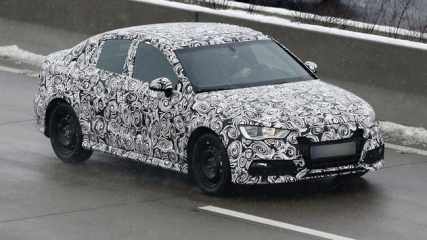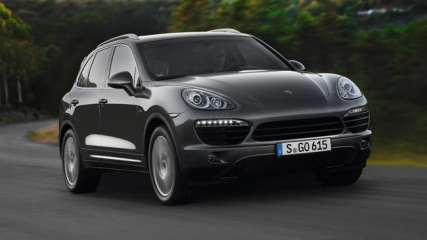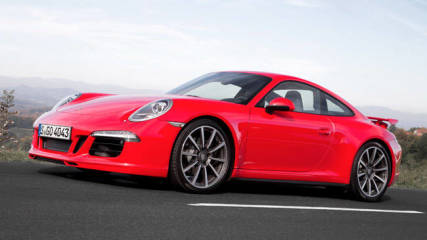Porsche 911 Carrera 2012 review
By Paul Pottinger · 01 Nov 2012
Four wheels good, two wheels ... Well, not "bad". Never bad. Not when they're the rear wheels of a 911. The triumphal and still fairly new 991 generation of the perennial sports car has been launched in its all-wheel-drive versions - Carrera 4, 4S and the equivalent Cabrios. Driven this week in the Austrian Alps, it was never going to be a question of these being better than the solely rear driven 911s.Rather it's down to your definition of "better". Is making the already incredibly adept 911 that bit more clinical and über capable is really such a good idea - especially in a car that is already too good to be used in Austria and leagues of magnitude too good for Australia?When asked what Carrera would do for him, Herr 911 himself - the model's project leader August Achleitner - tells Carsguide: "I would be satisfied with the C2 S. If you do not live among snow, the grip is massive."Indeed he says, when properly shod with Pirelli summer rubber and driven in optimum conditions, the ostensibly lesser 911 provides some 90 per cent of the C4's immense capability. "But," Achleitner says, "you feel better when you hand the keys to your wife." Or the likes of me.VALUEIf measured literally by metal for the money, there's no argument. The extent to which the wide bodied C4s are bigger than the C2s appears incremental on paper, but hugely imposing in physical appearance. More on that in a minute ...In showrooms by March (those that haven't been pre-bought) - the 3.4-litre 911 Carrera 4 Coupe is priced at $255,400 plus on-roads - the price of a VW Up over the previous model. The Carrera 4 Cabriolet is a base Polo dearer than its predecessor at $280,900. At $289,400 the stove hot 3.8-litre Carrera S 4S represents a rise of a Polo with DSG. The range topping $315,000 Carrera Cabriolet is getting into Golf country over the car that preceded it.Yet even without options (but always including the $5400 PDF twin clutch auto) the full panoply of which could equally be a Scirocco S over the previous car, the new Carrera 4s represents at least that great an advance. It's a tech tour de force.Realise also that more than $100,000 of each car's purchase price goes to Wayne Swan, who of course spends it on everyone's behalf, so don't go calling 911 drivers "bankers". They're contributing to the common good.TECHNOLOGYTo extol the Carrera 4's array of tech would not only be superfluous - you've read it all recently - but to risk being cast adrift in an ocean of acronyms. This time, we need discuss only Porsche Traction Management system, the slick electronic mechanism that shares the driving force around all four wheels, distributing power between the permanently driven rear axle and the front. It allows no more torque to be transmitted to the wheels than can be done without slip, reacting quicker than a mere human could hope.It's as active or passive as you yourself are behind the wheel, continuously monitoring including the rotational speed of all four wheels, the lateral and longitudinal acceleration of the car and the steering angle to send drive to where it will do most good. Blast off the mark hard enough to disturb traction and the multi-plate electronic clutch thrusts power aft. To cement the relationship of "proof" with "fool", another program prevents wheel spin by adapting the engine’s power output. During cornering, the optimal level of drive power is distributed to the front wheels to ensure excellent lateral stability.And if not for the event busy dashboard indicator that shows which end is doing how much work, you might never know what's the go. PTM might as well be a short form for "seamless". Or "flattering". Sorry but you alone are just not that good.Present and correct are the two tunes of Porsche's water-cooled flat six, with direct injection, variable valve timing, an aluminium block and every refinement to ensure that in 3.4 or 3.8 form, the C4 911s run barely an eyeblink behind the C2s.The Carrera 4 Coupe does the 0-100kmh run in 4.5 seconds, the Cabriolet in 4.7 - all of one tenth behind the rear wheel drive cars. The blazing S versions match their lighter siblings at 4.1 seconds in the Coupe and 4.3 in the drop top.DESIGNOn paper 44mm of extra width over the regular 911 looks very little. In practice, on narrow alpine roads crusted by frost with vertiginous drops, it feels like an extra metre. If unkind to driver's view (shrouded is too kind a word for the coupe's rear three quarter aspect) visibility is very much the point of the flared rear arches and wider wheels."This is why we have the wide body," Achleitner says. "People wish to show they can afford the most expensive model."Certainly the 911's cockpit no longer leaves you wondering where your quarter of a million bucks went. Indeed, Porsche appears to be over eager to demonstrate it. No less than 60 buttons festoon the centre console and mirror controls.While the wheel is free of these, its column spouts four wands and two gear shifting levers. There's a tonne of function, but form? Not so much.If being the 911's exterior designer is the equivalent to being Tony Abbott's speechwriter - give them more of the same then repeat endlessly - incremental changes become all the more impactful. The widened C4 looks weapons grade.SAFETYNo one's crash tested this and no one's going to. At any rate, the C4 sheer dynamic ability, underwritten by an exceptional array of active and passive electronic measures, means the human factor needs to be especially egregious if all is to end in road toll stats.So clinically, incredibly adept is the C4, I asked Achleitner if perhaps some of the sport had been removed from this classic sports car."To use an example from my own experience, I am a very enthusiastic manual transmission driver. But when you drive PDK, which can manage so wide a breadth of tasks, you can even as a lover of manual transmissions want to change to PDK," he says."All these systems and all-wheel-drive too - at Porsche we ask the question do we need these? They are not essential, but they improve the car. It makes its ability, its limits, higher. And the car never gets boring."DRIVINGCertainly the car - especially the full throated S - never sounds dull. When you've tired of the aural frenzy bought on by even a half enthusiastic throttle opening, you have tired of life.Even with its dynamic edge blunted by winter tyres, it is impossible not to be awestruck by this phenomenally sophisticated device for getting around corners quickly. You cannot reasonably complain about the feelful electric steering.You cannot but be delighted by the throttle blipping down changes of the PDK, transmission so adept, so incredibly intuitive that imposing your own will via manual changes is like pouring salt into an exquisite sauce or improving a Shakespearean tragedy with a happy ending. Your intervention is not only superfluous, but undesirable.Maybe that's a good thing.VERDICTFor when only the very best will do, even if the best is a bit too much.















